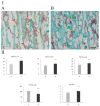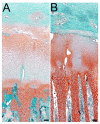Structural Changes in Trabecular Bone, Cortical Bone and Hyaline Cartilage as Well as Disturbances in Bone Metabolism and Mineralization in an Animal Model of Secondary Osteoporosis in Clostridium perfringens Infection
- PMID: 35011946
- PMCID: PMC8746067
- DOI: 10.3390/jcm11010205
Structural Changes in Trabecular Bone, Cortical Bone and Hyaline Cartilage as Well as Disturbances in Bone Metabolism and Mineralization in an Animal Model of Secondary Osteoporosis in Clostridium perfringens Infection
Abstract
There is no information regarding whether changes in the microbiological balance of the gastrointestinal tract as a result of an infection with Clostridium perfringens influence the development of metabolic bone disorders. The experiment was carried out on male broiler chickens divided into two groups: control (n = 10) and experimental (n = 10). The experimental animals were infected with Clostridium perfringens between 17 and 20 days of age. The animals were euthanized at 42 days of age. The structural parameters of the trabecular bone, cortical bone, and hyaline cartilage as well as the mineralization of the bone were determined. The metabolism of the skeletal system was assessed by determining the levels of bone turnover markers, hormones, and minerals in the blood serum. The results confirm that the disturbed composition of the gastrointestinal microflora has an impact on the mineralization and metabolism of bone tissue, leading to the structural changes in cortical bone, trabecular bone, and hyaline cartilage. On the basis of the obtained results, it can be concluded that changes in the microenvironment of the gastrointestinal tract by infection with C. perfringens may have an impact on the earlier development of osteoporosis.
Keywords: Clostridium perfringens; gastrointestinal; metabolic bone disorders; microflora; osteoporosis; short-term infection.
Conflict of interest statement
The authors declare no conflict of interest.
Figures





Similar articles
-
Clostridium perfringens challenge and dietary fat type affect broiler chicken performance and fermentation in the gastrointestinal tract.Animal. 2014 Jun;8(6):912-22. doi: 10.1017/S1751731114000536. Epub 2014 Mar 27. Animal. 2014. PMID: 24674938
-
Optimized necrotic enteritis model producing clinical and subclinical infection of Clostridium perfringens in broiler chickens.Avian Dis. 2010 Sep;54(3):1058-65. doi: 10.1637/9338-032910-Reg.1. Avian Dis. 2010. PMID: 20945788
-
Effects of dietary β-1,3-glucan addition on the growth performance, mRNA expression in jejunal barrier, and cecal microflora of broilers challenged with Clostridium perfringens.Poult Sci. 2023 Feb;102(2):102349. doi: 10.1016/j.psj.2022.102349. Epub 2022 Nov 19. Poult Sci. 2023. PMID: 36470029 Free PMC article.
-
Effects of osteoporosis medications on bone quality.Joint Bone Spine. 2007 Jan;74(1):39-47. doi: 10.1016/j.jbspin.2006.06.004. Epub 2006 Nov 28. Joint Bone Spine. 2007. PMID: 17196423 Review.
-
Necrotic enteritis predisposing factors in broiler chickens.Avian Pathol. 2016 Jun;45(3):275-81. doi: 10.1080/03079457.2016.1150587. Avian Pathol. 2016. PMID: 26926926 Review.
Cited by
-
Experimental Cyclic Heat Stress on Intestinal Permeability, Bone Mineralization, Leukocyte Proportions and Meat Quality in Broiler Chickens.Animals (Basel). 2022 May 16;12(10):1273. doi: 10.3390/ani12101273. Animals (Basel). 2022. PMID: 35625119 Free PMC article.
-
Necrotic enteritis affects bone growth and bone microstructure in non-selected conventional and modern meat-type chicken strains.Poult Sci. 2025 Aug;104(8):105343. doi: 10.1016/j.psj.2025.105343. Epub 2025 May 26. Poult Sci. 2025. PMID: 40466263 Free PMC article.
References
-
- Benno Y., Mitsuoka T. Development of intestinal microflora in humans and animals. Bifidobact. Microfi. 1986;5:13–25. doi: 10.12938/bifidus1982.5.1_13. - DOI
-
- Zubadalashvili N.G., Makhviladze M.A., Diasamidze M.T., Abdulashvili N.N. The comparative study of Linex and Lacto-G in treatment of adult patients with disbacteriosis. Georgian Med. News. 2009;170:38–42. - PubMed
LinkOut - more resources
Full Text Sources

